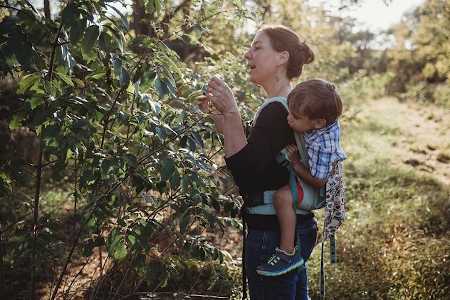Across the United States, farmers are taking innovative approaches to foster environmental stewardship and economic viability through a common conservation practice called the riparian forest buffer. Supporting production while enhancing conservation is an important goal of both US Department of Agriculture Secretary Perdue’s Agriculture Innovation Agenda (PDF, 196 KB) and of the USDA Forest Service. Agroforestry, the intentional integration of trees and crops and/or livestock to meet economic, conservation, and social goals, is one strategy that offers many innovative “productive conservation” options, including riparian buffers.
Multifunctional riparian buffers (PDF, 947 KB), or income-producing buffers, are the trees, shrubs, and other plants alongside rivers, streams, and wetlands that produce products that can be harvested and sold, such as fruits, nuts, and decorative woody floral species. By widening these buffers and planting more year-round cover, farmers are enhancing water quality, improving wildlife habitat, and protecting soil while also producing specialty crops that they can use or sell.

A plowed field adjacent to the multifunctional riparian forest buffer, planted with USDA Forest Service support, at the Catawba Sustainability Center managed by Virginia Tech.
To increase adoption of these buffers, the USDA National Agroforestry Center, or NAC, has spent years working with many partners to demonstrate, research, and provide guidance on buffer establishment and management. In 2012, NAC partnered with Virginia Tech to create a woody floral demonstration site that widened an existing riparian buffer at the Catawba Sustainability Center.
In 2016, NAC staff with assistance from Appalachian Sustainable Development and Virginia Tech, developed the Non-Timber Forest Product Calculator to estimate the income potential from harvesting and selling fruits, nuts and other species incorporated into buffers. Later that year, NAC partnered with the Pennsylvania Bureau of Forestry, Penn State University, and other partners to host multifunctional riparian forest buffer workshops for agriculture and natural resource professionals.
Partially funded by the USDA National Institute of Food and Agriculture’s Northeast Sustainable Agriculture Research and Education program, these workshops generated significant interest from landowners. Following on this success, in 2018 the state of Pennsylvania invested $3 million in grants over three years to promote the use of multifunctional riparian forest buffers. Landowners have been pleased with the results of the program, which is facilitated by consultants, non-profits, and others, many of whom participated in the earlier workshops.
Sarah DePasquale of Fiddler’s Bend Farm worked with a consulting forester to install her buffer. “Our buffer has revitalized a low-lying stream bank … into a thriving, diversified native planting,” she said. “I am thrilled to see the success of the elderberry, which I market as value-added syrup. Already the market for syrup and fresh berries outstrips the supply from these two-year-old plants, and I look forward to harvesting more as the plants mature.”
The story of multifunctional riparian buffers demonstrates how farmer innovation combined with Forest Service research, workshops and education can provide new ways to achieve conservation goals and diversify farmer income.

Sarah DePasquale of Fiddler’s Bend Farm in Pennsylvania harvests elderberries from her multifunctional riparian forest.
Source : usda.gov